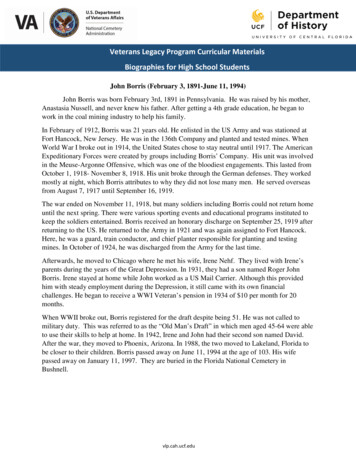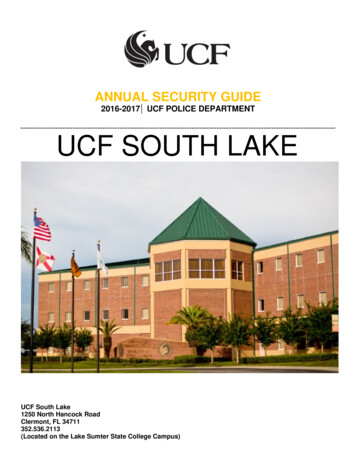
Transcription
VAU.S. Departmentof Veterans AffairsUCFNational CemeteryAdministrationDepartmentof HistoryUN I VERSITYOFCEN TR ALVeterans Legacy Program Curricular MaterialsBiographies for High School StudentsJohn Borris (February 3, 1891-June 11, 1994)John Borris was born February 3rd, 1891 in Pennsylvania. He was raised by his mother,Anastasia Nussell, and never knew his father. After getting a 4th grade education, he began towork in the coal mining industry to help his family.In February of 1912, Borris was 21 years old. He enlisted in the US Army and was stationed atFort Hancock, New Jersey. He was in the 136th Company and planted and tested mines. WhenWorld War I broke out in 1914, the United States chose to stay neutral until 1917. The AmericanExpeditionary Forces were created by groups including Borris’ Company. His unit was involvedin the Meuse-Argonne Offensive, which was one of the bloodiest engagements. This lasted fromOctober 1, 1918- November 8, 1918. His unit broke through the German defenses. They workedmostly at night, which Borris attributes to why they did not lose many men. He served overseasfrom August 7, 1917 until September 16, 1919.The war ended on November 11, 1918, but many soldiers including Borris could not return homeuntil the next spring. There were various sporting events and educational programs instituted tokeep the soldiers entertained. Borris received an honorary discharge on September 25, 1919 afterreturning to the US. He returned to the Army in 1921 and was again assigned to Fort Hancock.Here, he was a guard, train conductor, and chief planter responsible for planting and testingmines. In October of 1924, he was discharged from the Army for the last time.Afterwards, he moved to Chicago where he met his wife, Irene Nehf. They lived with Irene’sparents during the years of the Great Depression. In 1931, they had a son named Roger JohnBorris. Irene stayed at home while John worked as a US Mail Carrier. Although this providedhim with steady employment during the Depression, it still came with its own financialchallenges. He began to receive a WWI Veteran’s pension in 1934 of 10 per month for 20months.When WWII broke out, Borris registered for the draft despite being 51. He was not called tomilitary duty. This was referred to as the “Old Man’s Draft” in which men aged 45-64 were ableto use their skills to help at home. In 1942, Irene and John had their second son named David.After the war, they moved to Phoenix, Arizona. In 1988, the two moved to Lakeland, Florida tobe closer to their children. Borris passed away on June 11, 1994 at the age of 103. His wifepassed away on January 11, 1997. They are buried in the Florida National Cemetery inBushnell.vlp.cah.ucf.eduFLORID!'
VAU.S. Departmentof Veterans AffairsUCFNational CemeteryAdministrationDepartmentof HistoryUN I VERSITYOFCEN TR ALVeterans Legacy Program Curricular MaterialsBiographies for High School StudentsHenry Francis Cavicchi (September 4, 1896-July 30, 1991)Henry Cavicchi was born on September 4, 1896 in Plattsburgh, New York. His father, ErcoleCavicchi, was born in Bologna, Italy. He immigrated to the United States in the 1880s. His mother,Elmina, was originally from Quebec, Canada. Italian immigration to the United States increasedsignificantly in the late nineteenth and early twentieth centuries. In the 1880s, 300,000 people also cameto America from Italy. By the 1890s, this number doubled. This rise in immigration is attributed to ashortage of jobs in Europe. Many immigrants from Italy were poor farmers or laborers, and many, likeCavicchi’s father, were single men looking for better job opportunities. The large amounts of Italianimmigrants continued until 1924, with the Immigration Act of 1924. This created quotas on immigrantsbased on race and country of origin and limited the immigrant population in America.During the first decade of the twentieth century, Ercole Cavicchi moved his family toMassachusetts. There he started his own business in pursuit of the American Dream. He was a giftedinventor and entrepreneur. Many of his inventions focused on polishing stone floors. He also filed apatent in 1917 for a design for ship’s armor to protect civilian ships from torpedo attacks. This was likelyinspired by German submarine attacks. The design would either catch the torpedo before it hit or deflectthe torpedo.Henry worked in his father’s shop as a young man. He registered for the draft on June 5, 1918.He probably did not go overseas as the fighting ended two months after he enlisted. He was releasedfrom the navy in January of 1919. He enlisted as an Air Service Aircraft Rigger (ASAR). His jobinvolved putting cables around military planes before they went into action. This says volumes about thegrowing importance of airplanes involved in warfare by the end of the war. Planes began to servedifferent functions in combat, and were mostly used to counter the German submarines. Airplanes wereonly about a decade old but they already were important to the success of the navy by the time Cavicchijoined. Cavicchi’s work with airplanes foreshadows the growing utility and versatility of airplanes inwarfare that would occur in World War II.After the war, Henry returned to Massachusetts and married his wife Emily E. Sussex in 1922.They had four daughters and one son. Once he was back home, Cavicchi continued to work in his father’sstore, Cavicchi Polishing Machine Co. Ercole patented at least three inventions related to his polishingmachine business. The most recognizable was a mower-like machine used to polish floors. Ercole retiredin the 1930s and lived the last years of his life in St. Petersburg, FL. He died January 19, 1946. HenryCavicchi worked with his brothers at the family business. He registered in 1942 for the Old Man’s Draft.This was the conscription of men aged forty-five to sixty-four to help in the war effort at home. Thesemen did not see combat but were used in various positions of domestic service. In 1940, Cavicchi kept amaid.This suggests that he had a comfortable, middle class life. He retired to Florida with his wifeEmily. He passed away July 30, 1991 in Manatee Florida at the age of ninety-four. Emily passed awaytwo years later at the age of ninety-one.vlp.cah.ucf.eduFLORID!'
VAU.S. Departmentof Veterans AffairsUCFNational CemeteryAdministrationDepartmentof HistoryUN I VERSITYOFCEN TR ALVeterans Legacy Program Curricular MaterialsBiographies for High School StudentsEdward Patrick Connolly (October 31, 1922-September 7, 1995)Edward Connolly was born in 1922 to John and Emily Connolly in Boston,Massachusetts. He was the second youngest of seven children. His father worked as a policeofficer while his mother worked at home. His father became a well-known police officer afterdealing with Harry Shappas, a thief who pickpocketed several women. In March of 1930, hisfather died suddenly. Edward’s oldest sister Anna took charge of the house after their motherpassed away during the Depression. Anne worked as a librarian while one of his other sisters,Theresa, worked as a clerk at an insurance company. By 1940, his brothers Joseph and Thomaswere also working as clerks.After America entered World War II, thousands of American young men enlisted in themilitary. Edward enlisted in the US Marine Corps on December 26, 1941. The Marine Corpsbecame the Navy’s main army fighting in the Pacific Theater of the war, and Edward went to thePacific. On December 26, 1945, 23 year-old Edward finished his service with the rank ofcorporal.After returning to Massachusetts after the war, he met and married Thelma Snell. Theyhad two sons, Kevin and Mark. Edward decided to become a police detective, following in hisfather’s footsteps. In January of 1955, he was shot in the chest while stopping five gang membersfrom robbing the Astor Theater. In spite of being wounded, he shot back and chased them,ensuring that all five were apprehended. However, this incident caused him to retire from thepolice force. A few days later, on January 10, the city of Boston commended Connolly for hisheroism. On May 25, 1956, the city of Boston authorized an act to give Connolly an annualpension paid out monthly for his heroic acts which left him disabled. It would be equal to his ratereceived as compensation for his retirement from the police force. If he died it would go toThelma.He retired and moved to Ft Lauderdale, Florida and then Brevard County in 1982. Hepassed away on September 7, 1995 and is buried in the Florida National Cemetery in Bushnell.vlp.cah.ucf.eduFLORID!'
VAU.S. Departmentof Veterans AffairsUCFNational CemeteryAdministrationDepartmentof HistoryUN I VERSITYOFCEN TR ALVeterans Legacy Program Curricular MaterialsBiographies for High School StudentsRufe Goins (September 23, 1894 - December 25, 1988)Rufe Goins was born on September 23, 1894, in Coal Creek, Anderson County,Tennessee, to George Washington Goins, a farmer, and Almeda A. Goins. He was the secondyoungest of seven siblings: Venie, Sarah, Nicy, Charles, Idella, Burnettie, and Millard. AlthoughGoins was raised on a farm in rural Tennessee, he learned to read and write.On May 29, 1912, at the age of 21, Goins enlisted in the United States Army. He servedin the 19th Infantry Regiment in Texas for several years. At the time and place of Goins’sservice, the United States was engaged in the Border War with Mexico. During this war, theUnited States Army garrisoned American border towns, constructed forts alongside the border,and fought against Pancho Villa, a notable Mexican revolutionary. Goins was honorablydischarged on May 28, 1915. After being honorably discharged, Goins worked as a coal miner inJasonville, Indiana, a large mining community.America entered World War I in April 1917. Goins re-enlisted in the United States Armyon October 30, 1917. He served for two years and reached the rank of Private before he wasreleased on June 20, 1919, serving more than half a year past the end of the war in November1918. Unfortunately, there are no documents that detail his service during World War I.After being released from the army, Goins returned to Tennessee and married MaudeEtter Herrell in 1922. Their first son, Wade F. Goins, was born around 1927. Before 1930, theGoins family moved to the city of East Chicago, Lake County, Indiana, where Goins worked as amachines helper and laborer at a steel plant and Maude worked as a housekeeper. Despite highunemployment and suffering around the nation, Rufe could work in the Indiana steel industry,which included the Gary Works U.S. Steel Mill in Gary, Indiana, the world’s largest at the time.President Franklin D. Roosevelt’s New Deal played a key role in Rufe’s life, passing legislationhelping steel workers unionize. Plus, Rufe’s service in the Army likely gave him an edge infinding work, as the New Deal prioritized veterans. This work helped Goins support his growingfamily. His second son, Donald Edward Goins, was born on June 27, 1935. The Goins familyremained in Lake County, Indiana, through the 1950s. They moved to the city of Hammondsometime before 1952, where Goins worked as a blacksmith.Like many retirees, Goins moved from Hammond, Indiana, to Tampa, Florida in 1959. Itis possible that Goins moved to Tampa to retire, since he was 65 at the time of their move. Whileliving in Tampa, Maude Goins worked as a homemaker and was a member of the Tampa BaptistChurch. Rufe Goins died on December 25, 1988, in Tampa, Florida, at the age of 94. He wasburied at Florida National Cemetery in Bushnell, Florida, on December 28, 1988. His wife,Maude, died ten years later and is buried with him.vlp.cah.ucf.eduFLORID!'
VAU.S. Departmentof Veterans AffairsUCFNational CemeteryAdministrationDepartmentof HistoryUN I VERSITYOFCEN TR ALVeterans Legacy Program Curricular MaterialsBiographies for High School StudentsWilliam Otto Grupp, April 1, 1901-November 17, 1988Firefighter Second Class William Otto Grupp was born April 1, 1901 in Brooklyn, NewYork. His parents were German-born William F. Grupp and New York-born Elizabeth Grupp.In 1910, William F. Grupp was employed as a machinist and the family resided in New York.On July 5, 1918, William Otto Grupp enlisted into the United States Navy at the age ofeighteen. He was discharged on June 14, 1919. Grupp served in several locations. He wasstationed in Newport, Road Island from June 5, 1918 to August 28 as a Fireman Third Class,then to a naval base in Norfolk, Virginia from August 28, 1918 to September 6th, where he waspromoted to Fireman Second Class. On September 1918, Grupp served on the USS Indiana untilNovember 8, 1918. He was then sent to the receiving ship in New York where he remained untilthe end of the war. According to his granddaughter Denise Surdukowski, Grupp occasionallyworked in the infirmary and once helped transport mules. He also worked on the USS Indiana, atraining ship off the coast of Tomkinsville, New York and in the York River near Virginia.William returned to his parents’ home in 1919.The Grupp family chose to keep their German name, a remarkable choice consideringAmerican Anti-German sentiment at the time. Historian Peter C. Weber states that as theAmerican home front sought to “eradicate” German culture, German-Americans either deGermanized or stuck together. Historian Frederick C. Luebke elaborates further that GermanAmericans reacted in several ways to American “superpatriotism.” Some celebrated theirGerman heritage, while others hid it. Luebke concludes that “most Germans in America heldattitudes somewhere between the pro-German and superloyalist extremes.” William Grupp andhis family’s decisions seem to support this conclusion. The Grupp family did not change theirname to a more “American” one. This suggests a deep pride in their heritage. However, Williamalso served the United States in the First World War, alluding to a pride and responsibilitytowards his American heritage.William married Katherine Riebling in 1921 in New York. Katherine was born August 8,1901 in Queens, New York. In 1920, she was working as a packer in a knitting house, and livingwith her brother-in-law. By 1925 she and William had their own home. The couple had twodaughters, Katherine and Dorothy. Katherine worked as a janitor while William worked as achauffeur for Borden’s Milk. During the Great Depression, Katherine’s brother John Rieblinglived with them.At some point after 1940, William went on to work for Schlitz Beer. The brewery,founded in 1849, would later become renowned as “The beer that made Milwaukee famous.”Like many breweries opened in the nineteenth century, Schlitz was an outlet for many GermanAmericans to safely and beneficially express their heritage, as well as make a name forthemselves. After facing rationing and anti-German sentiment during the Second World War,vlp.cah.ucf.eduFLORID!'
VAU.S. Departmentof Veterans AffairsUCFNational CemeteryAdministrationDepartmentof HistoryUN I VERSITYOFCEN TR ALVeterans Legacy Program Curricular MaterialsBiographies for High School StudentsSchlitz would ultimately become the best-selling beer in the United States by 1950. Williamremained under their employ until retiring.William died November 17, 1988 in Hudson, Pasco, Florida, followed by KatherineGrupp in February 24, 1991. Both are buried in the Bushnell National Cemetery. Theirdaughters, Katherine and Dorothy, are the Grupps’ Legacy. Schlitz Beer was on the decline by1970 as an independent company, and was ultimately acquired by their rival Pabst BrewingCompany in 1999. Katherine currently suffers from dementia, while Dorothy is in the care of herchildren. The Grupp legacy continues to this day under William and Katherine’s grandchildrenwho cherish their grandparents’ memory.vlp.cah.ucf.eduFLORID!'
VAU.S. Departmentof Veterans AffairsUCFNational CemeteryAdministrationDepartmentof HistoryUN I VERSITYOFCEN TR ALVeterans Legacy Program Curricular MaterialsBiographies for High School StudentsArchie Hawkins (February 12, 1902 - February 27, 1989)In February 1902, not quite 40 years after the abolition of slavery, Doc and LillyHawkins gave birth to a boy named Archie. Archie was raised in northern Florida in the city ofLloyd. Hawkins was illiterate and worked as a farm laborer in Lloyd. World War I began in 1914but America did not enter until April 1917. Many African Americans were eager to fight inhopes to gain more rights and liberties by serving their country. Hawkins joined the Army alongwith approximately two hundred other black men from Jefferson county. Hawkins attempted toregister for the draft on two separate occasions changing his birth year to make him twenty-oneand eligible for service. On September 26, 1918 Hawkins was drafted.Hawkins was assigned to a segregated support unit in Jacksonville Florida. This was acavalry regiment that never saw any action overseas, however they still faced dangers such asdisease and workplace dangers in the camp. After three hard months, Hawkins was dischargedon December 14, 1918 with the end of World War I.After the war, Hawkins, along with other black veterans, faced hostility from thecommunity. The summer after the conclusion of war saw many episodes of violence, racism anddiscrimination that came to be known as the Red Summer. A “Welcome Home” reception heldon September 25, 1919 claimed to be “free to all men in uniform,” yet, African Americanveterans were excluded from the event.Through his service Hawkins became literate but faced many obstacles after the warended. Hawkins remained in Lloyd, Florida until he moved to St. Petersburg in 1929, where heworked as a landscape gardener until he retired. He had a daughter named Doris Washingtonwho fostered eight children, ten grandchildren and two great-grandchildren. Hawkins died onFebruary 27, 1989 in Pinellas county, Florida and is remembered at Florida National Cemetery inBushnell, Florida.vlp.cah.ucf.eduFLORID!'
VAU.S. Departmentof Veterans AffairsUCFNational CemeteryAdministrationDepartmentof HistoryUN I VERSITYOFCEN TR ALVeterans Legacy Program Curricular MaterialsBiographies for High School StudentsEarl J. LaPan (August 24, 1908 - February 19, 1996)Earl J. LaPan was born in Lowell, Massachusetts on August 24, 1908. Throughout hislife, Earl J. LaPan was an accomplished artist, with many of his works still on display in southernFlorida. Earl LaPan began his art career in New Jersey and moved to Florida during the GreatDepression, painting several works of art throughout the hotels of Miami.During the Great Depression, artists like Earl LaPan benefitted greatly from New Dealpolicies such as the Federal Arts Project. From 1935 to June 1943, the Federal Arts Projectspanned 48 states and had many active community art centers, including art centers in Miami andthe Florida Keys. Throughout the Great Depression, Earl LaPan created over 300 muralsdepicting tropical scenes.Earl LaPan’s work as an artist came to a pause when he was drafted into the Army AirCorps. Unfortunately, any military documents that may have further recorded LaPan’s time inthe Army Air Corps have been difficult to recover.After World War II, Earl LaPan married Alice Pearse in Miami. There, he went back towork as an artist. Among the most notable of his pieces is The Mariner, a fourteen-foot statuecreated for the Mariner Bank in 1978 which cost 18,000. After the bank closed, the statue wasmoved to Phil Foster Park.Another statue created by LaPan was two rearing horses, standing ten feet high, andweighing one ton. Because lack of repair, one of the horses fell during a storm in 2005, and theother was deemed a danger to the community so the entire statue was replaced a year later.Earl J. LaPan served his country in World War II, but he went on to become a famoussculptor and painter after the war. Some of his most notable achievements in life were from hiswork as an artist. The murals and statues that he created are now becoming eligible as historiclandmarks, and will ultimately be a legacy that he leaves behind.vlp.cah.ucf.eduFLORID!'
VAU.S. Departmentof Veterans AffairsUCFNational CemeteryAdministrationDepartmentof HistoryUN I VERSITYOFCEN TR ALVeterans Legacy Program Curricular MaterialsBiographies for High School StudentsPeter Nadzeika Sr. (January 5, 1919 - January 1, 1996)Peter Nadzeika was born a first-generation American citizen in Newark, New Jersey onJanuary 5, 1919. Peter’s parents, either Zenon or Zeno and Eva Nadzeika, immigrated to theUnited States from Lithuania. Peter’s mother, Eva, immigrated in 1906 and his father immigratedto New York in 1910. Peter grew up with his older brothers Frank and John in Morris County,New Jersey. Before the war, Peter worked in textile manufacturing, as well as on his parents’farm and tavern. Farmers throughout the country felt the impact of the Great Depression in the1930s as prices for agricultural goods suddenly declined. However, truck farms in New Jerseylike the Nadzeika family’s sold goods to “nearby urban centers” and so they “fared better thanthose in states dependent upon the production of cotton, wheat, and hogs.” Funds from theFederal Emergency Relief Administration (FERA) and other New Deal programs provided aid toNew Jersey residents to ameliorate hunger and unemployment, and it is possible that theNadzeika family benefitted from these measures.Peter enlisted as a private on March 7, 1941, at the age of 22. When he enlisted he was asingle, unmarried man and had completed four years of high school. John Nadzeika also servedin the war as a Merchant Marine. Peter went home after the war and worked in his father's tavernalongside his brothers. In 1975 Peter moved to New Port Richey, Florida. Peter had two sons,Peter Nadzeika Jr., and Michael Nadzeika, and at the time of his death had five grandchildren.Peter’s obituary in the Tampa Tribune mentions his service, alluding to its importance in his lifeby stating that he “was a retired tavern owner, Catholic and a veteran of World War II, serving inthe U.S. Army.” Peter lived in New Port Richey for the remainder of his life, until he died onJanuary 1, 1996, just shy of his 77th birthday. He was buried at Florida National Cemetery inBushnell, Florida.vlp.cah.ucf.eduFLORID!'
inspired by German submarine attacks. The design would either catch the torpedo before it hit or deflect the torpedo. . However, this incident caused him to retire from the police force. A few days later, on January 10, the city of Boston commended Connolly for his heroism. On May 2










